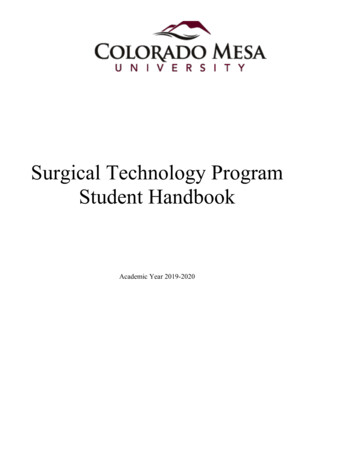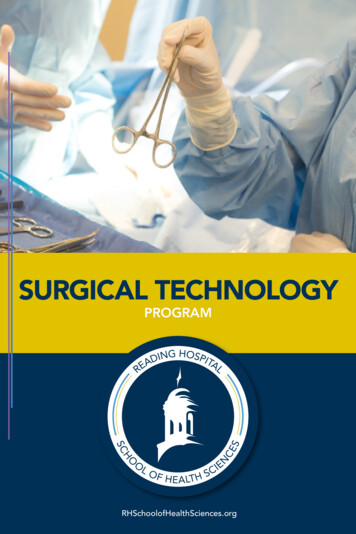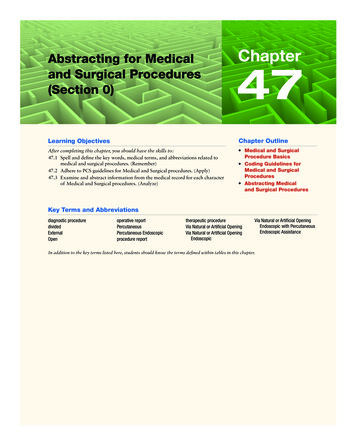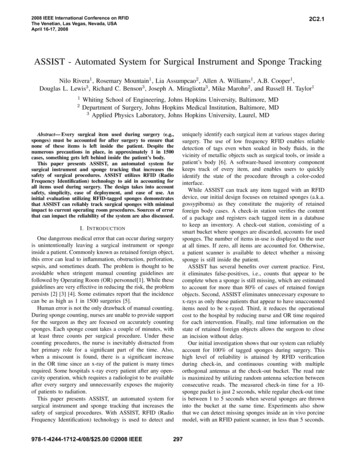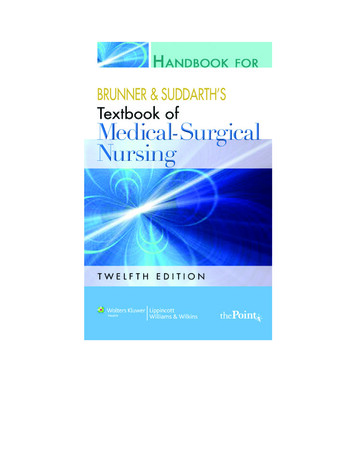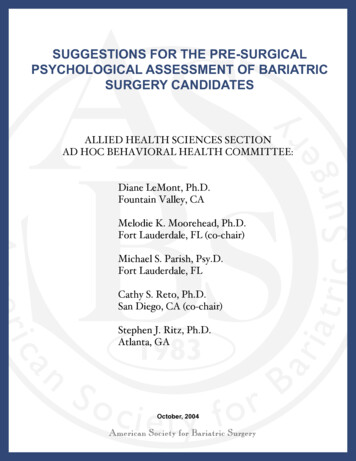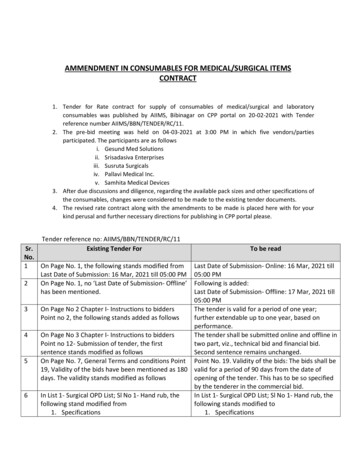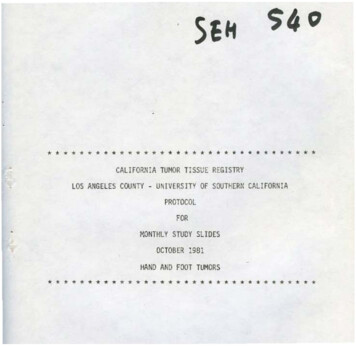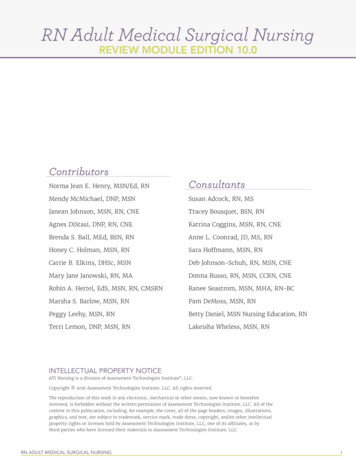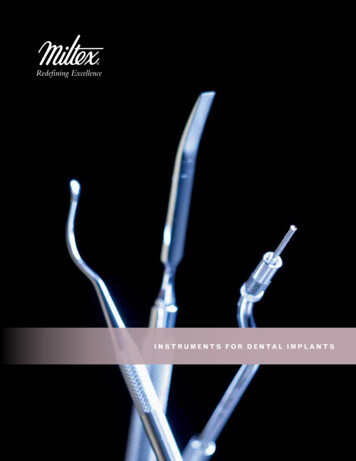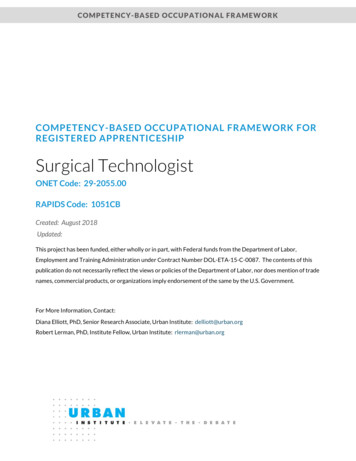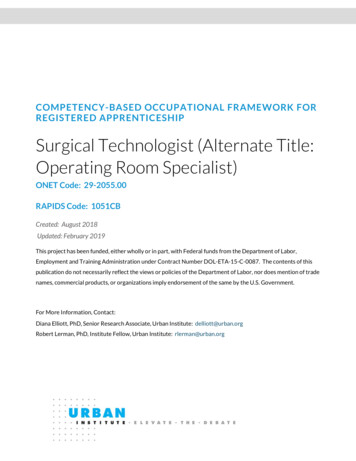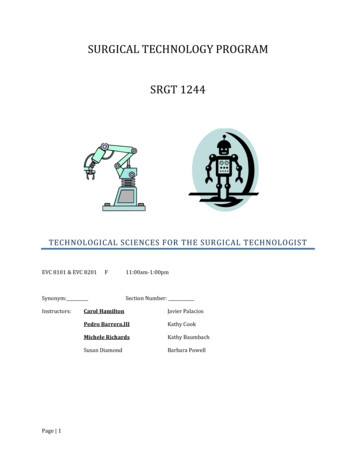
Transcription
SURGICAL TECHNOLOGY PROGRAMSRGT 1244TECHNOLOGICAL SCIENCES FOR THE SURGICAL TECHNOLOGISTEVC 8101 & EVC 8201FSynonym:Instructors:Page 1Carol Hamilton11:00am-1:00pmSection Number:Pedro Barrera,IIIJavier PalaciosMichele RichardsKathy CookSusan DiamondBarbara PowellKathy Baumbach
CONTENTSSurgical Technology Program. 3SRGT 1244: TECHNOLOGICAL SCIENCES FOR THE SURGICAL TECHNOLOGIST . 3Schedule of Topics and Assignments . 5Program Level Student Learning Outcomes . 6Course Level Outcomes and objectives . 6SCANS .10ACC Course Policies.11Page 2
AUSTIN COMMUNITY COLLEGESURGICAL TECHNOLOGY PROGRAMSRGT 1244: TECHNOLOGICAL SCIENCES FOR THE SURGICAL TECHNOLOGISTDESCRIPTIONIn-depth coverage of specialized surgical modalities. Areas covered include endoscopy,microsurgery, therapeutic surgical energies, and other integrated science technologies.PREREQUISITESBIOL 2404, BIOL 2420, and HPRS 1206 and admission into the Surgical Technology programSRGT 1505, SRGT 1509, and SRGT 1160COREQUISITESCOURSE RATIONALEThe purpose of this course is to provide an in-depth coverage of specialized surgical modalities.Areas covered include endoscopy, microsurgery, therapeutic surgical energies, and other integratedscience technologies.GRADESFinal grades are determined by the percentage of total points accumulated. Points are awarded as thefollowing:Attendance*Assignments15 points per class attended.100 points per assignment.Exam 100 points Total of 100 points possibleTotal of 210 points possibleTotal of 300 points possible**Total possible points 610 points** In the event that additional assignments are made, the point total will be adjusted accordingly. Grades willstill be averaged as described.Grades will be averaged according to scale:100%-90% A89%80% B79%-70% C69%-60% D60%or below F** In the event that additional assignmentsare made, the point total will be adjustedaccordingly. Grades will still be averaged asdescribed.NOTES: Assignments that are turned in late will be subject to a 10% deduction per day from the total points allotted.Late assignments will not be accepted more than one week past their due date.Page 3
There will be one exam, which will be a comprehensive final. Questions will come from reading assignmentsand lecture material, so pay attention and TAKE NOTES when topics are presented! One week after guestlectures, you will receive a worksheet to help you when studying for the final. A makeup final will not beavailable unless permission is granted by a faculty panel.INSTRUCTIONAL METHODOLOGYThis course is taught in the classroom in a lecture format along with demonstrations by the instructor. Thelecture also includes guest speakers.INSTRUCTORSNameOfficeOffice PhoneOfficeHoursE-mailJavier PalaciosEVC 8205(512) 223-5806PostedJpalaci1@austincc.eduPedro BarreraMichele RichardsSusan DiamondKathy CookBarbara PowellKathy BaumbachCarol HamiltonEVC 8203.4EVC 8203.1EVC 8281RRC 3117.04EVC 8203.2RRC 3117.07EVC 8203.3(512) 223-5801(512) 223-5803(512) 223-5807(512) 223-0238(512) 223-5802(512) 223-0243(512) duAttendance will be taken at the start of each class, since attending the class earns points for the final grade.One point will be deducted for each minute a student is tardy.In addition, one point for each minute a student leaves early will be deducted from the grade total.Required: Page 4TEXTBOOKSBerry and Kohn’s Operating Room Technique (12th ed.)
SRGT 1244SCHEDULE OF TOPICS AND ASSIGNMENTSElectricity, physics, and electrosurgical safetyComputers (Assignment)EndoscopyEndoscopyReading AssignmentPP 350-354; handoutsHandout/activityPP 640-653,handoutsEndoscopyEndoscopyMicroscopes & Specialty Tables (TBA)PP 362-367; HandoutsLaser (TBA)PP 355-361; handoutsRadiology ( TBA)TBAPP 217-220; PP 390-395; Study sheetSonography (TBA); Image guided (TBA)handoutRobotics (TBA)PP 653-655; study sheet to be providedAll Hazards PreparationUltrasonic Scalpel(TBA)Comprehensive FinalhandoutNone; study sheet to be providedNOTE: Due to the high number of guest speakers and the need to confirm their schedules, thisschedule will be adjusted accordingly (see TBA dates). All subjects listed will be covered. Schedulechanges will be announced ahead of time.LAST DAY TO WITHDRAW: 4/27/2015Page 5
PROGRAM LEVEL STUDENT LEARNING OUTCOMESUpon successful completion of the program, students will be able to: Utilize appropriate medical terminology.Apply a basic understanding of human physiology and surgical anatomy to the perioperative role of asurgical technologist.Demonstrate a basic understanding of the concepts of pharmacology.Demonstrate theoretical and practical proficiency in surgical aseptic technique, surgical proceduresand patient care.Identify and assume appropriate responsibility for patient care.Relate diagnosis with surgical procedure.Relate anatomy with surgical procedure.Integrate learning from one surgical procedure into subsequent surgical procedures.COURSE LEVEL OUTCOMES AND OBJECTIVESUpon successful completion of the course, students will be able to:Performance ObjectivesCOMPUTERSThe learner will: Describe basic components of a computer system.Apply computer knowledge to the educational process and safe patient care practices in the OR.Locate and evaluate information using the latest technology available.Performance ObjectivesThe learner will: Page 6ENDOSCOPYIdentify various endoscopic procedures.Identify and describe the use of basic equipment necessary for various endoscopic procedures.Discuss the differences in procedures performed in an endoscopy suite versus proceduresperformed in a surgical suite.Discuss potential complications of laparoscopic surgery.
ELECTRICITY AND PHYSICS/ ELECTROSURGICAL SAFETYPerformance ObjectivesThe learner will: Discuss the principles of electricity and electrical flow.Demonstrate electrical knowledge as it relates to patient safety.Define circuit, conductor, current, frequency, ground, insulator, isolated circuit, radio frequency,resistance, voltage, hertz, load, cycle.Apply basic principles of electrical flow related to electron theory, magnetism, volts, and amps.Compare direct current (DC) and alternating current (AC).Analyze and apply basic principles of electrical safety when using insulators, grounded plug,protecting self, equipment safety, electrical shock, and fire triangle component.Performance ObjectivesROBOTICSThe learner will: Describe the robotic terms as related to surgeryDescribe the surgical applications of roboticsIdentify the basic components of equipment used in robotic surgeryDescribe the movements of the robotic system manipulators.Apply the principles of robotics to patient safety.Performance ObjectivesRADIOLOGYThe learner will: Define radiologyDiscuss the interaction between radiology and the operating room.Identify various radiological methods used in the O.R.Discuss safety issues related to radiology.Performance ObjectivesIMAGE GUIDEDThe learner will: Discuss and define image guided technology as it pertains to surgery.Identify surgical procedures that may utilize image guided technologyPerformance ObjectivesThe learner will: Page 7SONOGRAPHYDefine ultrasound / ultrasonography.Identify surgical procedures that may utilize ultrasonography.
Performance ObjectivesULTRASONIC SCALPELThe learner will: Discuss the basic principles of how the scalpel dissects, coagulates, and coapts tissue.Compare and contrast the use of ultrasonic energy with the electrosurgical unit.Explain how to test the unit and assemble the handpieces.Performance ObjectivesMICROSCOPESThe learner will: Identify the various types of microscopes and their common uses in the OR.Identify four surgical procedures that may utilize a surgical microscope.Discuss methods involved in draping the surgical microscope.Performance ObjectiveSPECIALTY TABLESThe learner will: Identify the various types of surgical tables used in the OR.Correlate specialty tables with the type of surgical procedure which may utilize the table.Identify four specialty tables used in surgical procedures.Identify a surgical procedure that may use each specialty table discussed in class.Performance ObjectivesLASER AND LASER SAFETYThe learner will: Define the acronym L.A.S.E.R. and outline the basic physics and components of a laser.Identify the various types of surgical laser systems and their common applications.List the advantages and disadvantages of laser usage in surgery.Assess the function, pertinent assembly, use, and care of lasers in the surgical environment.Discuss safety concerns associated with laser use in surgery.Describe the safety precautions taken with the various types of lasers.Performance ObjectivesThe learner will: Page 8ALL-HAZARDS PREPARATIONDescribe disasters or public health emergencies that impact public health including the differenttypes along with the general health, safety, and security risks.Describe the all-hazards frameworkExplain key components of personal family, institutional, community and regional disasterpreparation and planning as related to the following:
oooooo Page 9Available informational resourcesSpecial needs of individualsDetectionImmediate responseShort Term InterventionsLong Term InterventionsDescribe communication strategies and procedures used in a disaster including, barriers tocommunicating and disseminating health information, reporting systems and procedures forcontacting family, coworkers, and local authorities.Describe the purpose and relevance of disaster support services including rationale forintegration and coordination of all systems:o National Response Framework (NRF)o National Incident Management Systems (NIMS)o Hospital Incident Command System (HICS)Describe the potential impact of mass causalities on the clinical and public health resourcesincluding infection control precautions, personal protective equipment, and documentationprocedures.Explain the role of triage as a basis of prioritizing or rationing health care services for victims.Describe the possible medical and mental health consequences, interventions, and solutions formanaging those affected including the psychological, emotional, cultural, religious, and forensicconsiderations for management of mass fatalities and resources, supplies, and services available.o Immediate careo Mass fatality managemento Mass evacuationo Mass shelteringo Prolonged shelteringExplain both the basic life-saving and life support principles and procedures that can be used at adisaster scene.Describe issues relevant to the management of individuals of all ages, populations, andcommunities affected by a disaster or public health emergency:o Moralo Ethicalo Legalo RegulatoryDescribe the support roles of the surgical technologist in a disaster.
SCANSIn 1994, the U.S. Department of Labor established the Secretary's Commission on Achieving Necessary Skills(SCANS) to examine the demands of the workplace and whether our nation's students are capable of meetingthose demands. The Commission determined that today's jobs generally require competencies in thefollowing n:Systems:Technology:Identifies, organizes, plans, and allocates resourcesAcquires and uses informationAcquires and uses informationUnderstands complex interrelationshipsWorks with a variety of technologiesThe Texas Higher Education Coordinating Board requires that all degree plans in institutions of highereducation incorporate these competencies and identify to the student how these competencies are achievedin course objectives.This course, Surgical Procedures I, incorporates the SCANS competencies in the following ways:COMPETENCEEXAMPLE OF LEVELInterpersonalShares experiences and knowledge with classmates, works as amember of a team for any assigned sic SkillsThinking SkillsPersonal QualitiesPage 10Identifies equipment needed for a given procedure. Allocatestime for studying.Identifies equipment needed based on surgical procedurescheduled.Understands the systems of the organization and theorganizations ultimate goal (i.e., excellent patient care)Discusses special surgical equipment, its functions andtroubleshooting techniques. Discusses endoscopic equipment,robotics, radiologic, laser and other surgical modalities. Preparesand submits an assignment through computer technology.Reads assigned pages.Identifies and prepares equipment needed for a given procedurebased on individual patient statusWorks as a team member for any assigned activities. Asserts self andnetworks with classmates and guest speakers to obtain information oncurrent topics.
ACC COURSE POLICIESATTENDANCE/CLASS PARTICIPATIONRegular and punctual class and laboratory attendance is expected of all students. If attendance or compliancewith other course policies is unsatisfactory, the instructor may withdraw students from the class.WITHDRAWAL POLICYIt is the responsibility of each student to ensure that his or her name is removed from the roll should he orshe decide to withdraw from the class. The instructor does, however, reserve the right to drop a studentshould he or she feel it is necessary. If a student decides to withdraw, he or she should also verify that thewithdrawal is submitted before the Final Withdrawal Date. The student is also strongly encouraged to retaintheir copy of the withdrawal form for their records.Students who enroll for the third or subsequent time in a course taken since Fall, 2002, may be charged ahigher tuition rate, for that course.State law permits students to withdraw from no more than six courses during their entire undergraduatecareer at Texas public colleges or universities. With certain exceptions, all course withdrawals automaticallycount towards this limit. Details regarding this policy can be found in the ACC college catalog.INCOMPLETESAn instructor may award a grade of “I” (Incomplete) if a student was unable to complete all of the objectivesfor the passing grade in a course. An incomplete grade cannot be carried beyond the established date in thefollowing semester. The completion date is determined by the instructor but may not be later than the finaldeadline for withdrawal in the subsequent semester.STATEMENT ON SCHOLASTIC DISHONESTYA student attending ACC assumes responsibility for conduct compatible with the mission of the college as aneducational institution. Students have the responsibility to submit coursework that is the result of their ownthought, research, or self-expression. Students must follow all instructions given by faculty or designatedcollege representatives when taking examinations, placement assessments, tests, quizzes, and evaluations.Actions constituting scholastic dishonesty include, but are not limited to, plagiarism, cheating, fabrication,collusion, and falsifying documents. Penalties for scholastic dishonesty will depend upon the nature of theviolation and may range from lowering a grade on one assignment to an “F” in the course and/or expulsionfrom the college. See the Student Standards of Conduct and Disciplinary Process and other policies T RIGHTS AND RESPONSIBILITIESStudents at the college have the rights accorded by the U.S. Constitution to freedom of speech, peacefulassembly, petition, and association. These rights carry with them the responsibility to accord the same rightsto others in the college community and not to interfere with or disrupt the educational process. Opportunityfor students to examine and question pertinent data and assumptions of a given discipline, guided by theevidence of scholarly research, is appropriate in a learning environment. This concept is accompanied by anequally demanding concept of responsibility on the part of the student. As willing partners in learning,students must comply with college rules and procedures.Page 11
STATEMENT ON STUDENTS WITH DISABILITIESEach ACC campus offers support services for students with documented disabilities. Students with disabilitieswho need classroom, academic or other accommodations must request them through the Office for Studentswith Disabilities (OSD). Students are encouraged to request accommodations when they register for coursesor at least three weeks before the start of the semester, otherwise the provision of accommodations may bedelayed.Students who have received approval for accommodations from OSD for this course must provide theinstructor with the ‘Notice of Approved Accommodations’ from OSD before accommodations will be provided.Arrangements for academic accommodations can only be made after the instructor receives the ‘Notice ofApproved Accommodations’ from the student.Students with approved accommodations are encouraged to submit the ‘Notice of ApprovedAccommodations’ to the instructor at the beginning of the semester because a reasonable amount of time maybe needed to prepare and arrange for the accommodations.Additional information about the Office for Students with Disabilities is available athttp://www.austincc.edu/support/osd/SAFETY STATEMENTAustin Community College is committed to providing a safe and healthy environment for study and work. Youare expected to learn and comply with ACC environmental, health and safety procedures and agree to followACC safety policies. Additional information on these can be found at http://www.austincc.edu/ehs. Becausesome health and safety circumstances are beyond our control, we ask that you become familiar with theEmergency Procedures poster and Campus Safety Plan map in each classroom. Additional information aboutemergency procedures and how to sign up for ACC Emergency Alerts to be notified in the event of a seriousemergency can be found at http://www.austincc.edu/emergency/.Please note, you are expected to conduct yourself professionally with respect and courtesy to all. Anyone whothoughtlessly or intentionally jeopardizes the health or safety of another individual will be dismissed fromthe day’s activity, may be withdrawn from the class, and/or barred from attending future activities.You are expected to conduct yourself professionally with respect and courtesy to all. Anyone whothoughtlessly or intentionally jeopardizes the health or safety of another individual will be immediatelydismissed from the day’s activity, may be withdrawn from the class, and/or barred from attending futureactivities.USE OF ACC EMAILAll College e-mail communication to students will be sent solely to the student’s ACCmail account, with theexpectation that such communications will be read in a timely fashion. ACC will send important informationand will notify you of any college related emergencies using this account. Students should only expect toreceive email communic
surgical technologist. Demonstrate a basic understanding of the concepts of pharmacology. Demonstrate theoretical and practical proficiency in surgical aseptic technique, surgical procedures
